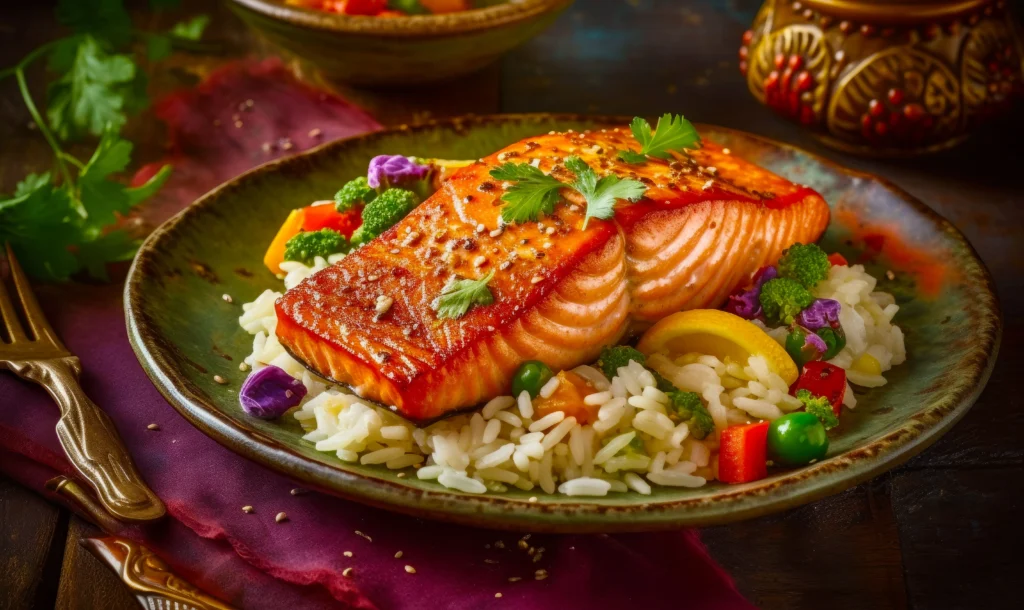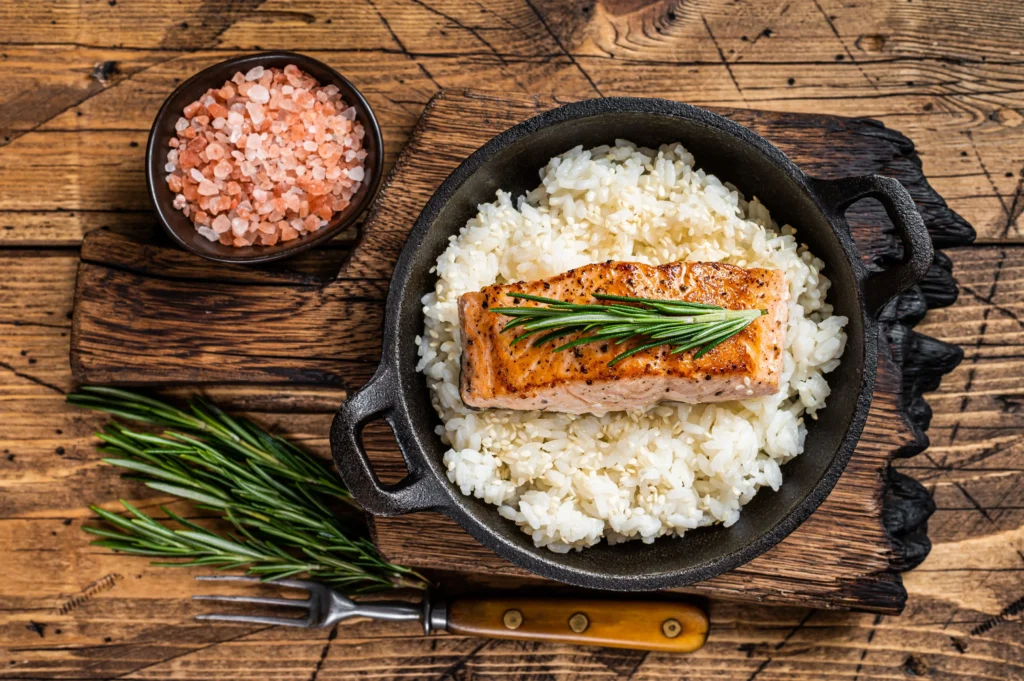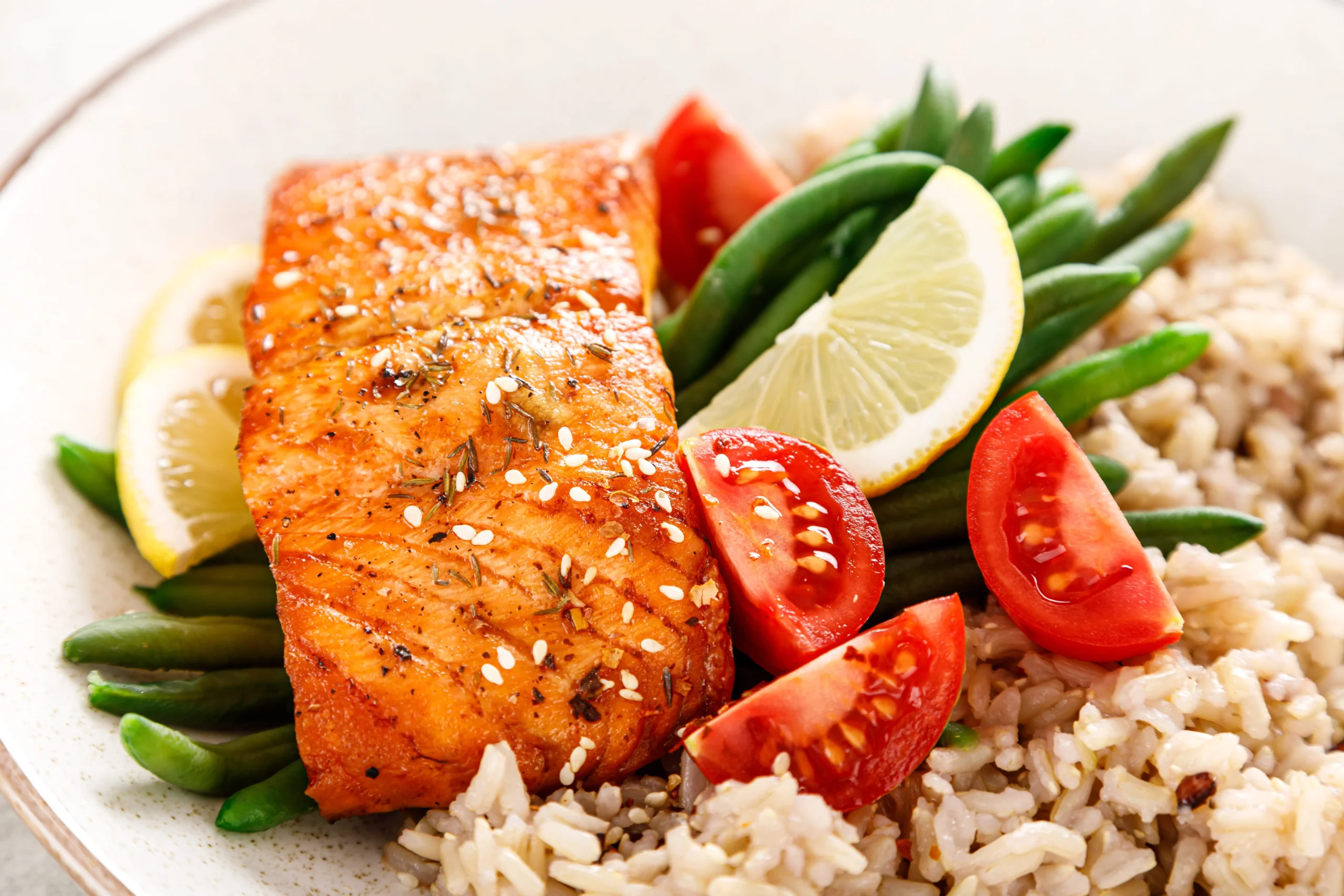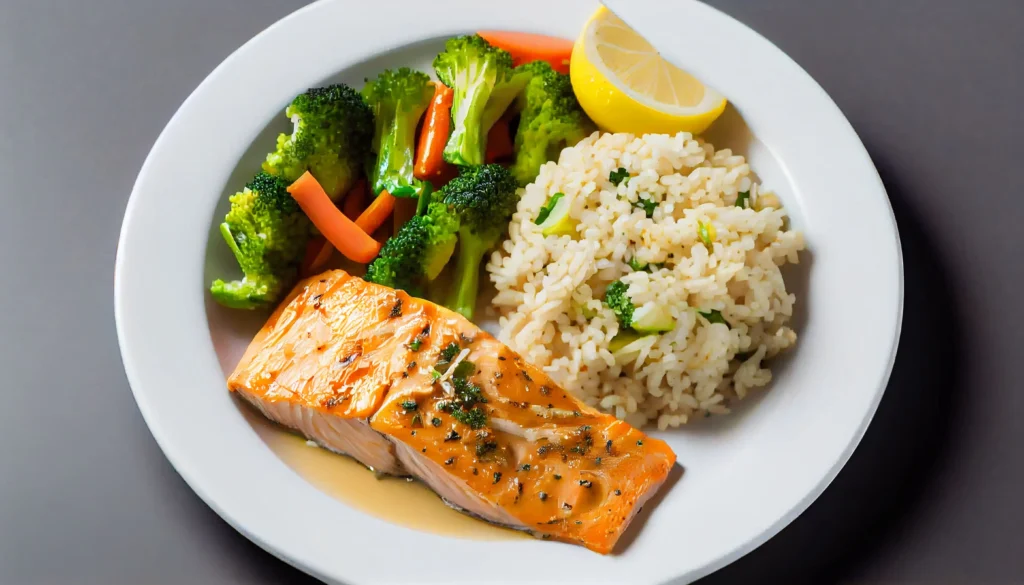Salmon and Wild Rice Recipes
Introduction to the Dish
Explore the world of Salmon and Wild Rice Recipes, a delightful fusion long celebrated in culinary traditions for its rich flavors and nutritional benefits. This classic combination not only tantalizes the taste buds but also brings a wealth of health benefits to your dining table.
Historical Significance: The tradition of cooking with salmon, especially in regions like the Pacific Northwest where it is naturally abundant, dates back centuries. Wild rice, with its robust, nutty flavor, has its roots in North American indigenous cultures, making it a revered ingredient in these recipes.
Popularity: In contemporary cuisines, the fusion of salmon and wild rice has gained popularity, appreciated for its versatility and ease of preparation.
Nutritional Value: Salmon and Wild Rice Recipes are not just about great taste. Salmon, known for its high Omega-3 fatty acid content, is essential for heart health. Wild rice, a great source of fiber and antioxidants, complements salmon perfectly, creating a meal that is as nutritious as it is delicious.”
Selecting Ingredients for Salmon and Wild Rice Recipes
Choosing the Right Type of Salmon
The type of salmon you choose can significantly impact the flavor and quality of your dish. Here are key points to consider:
- Wild vs. Farmed Salmon: Wild salmon, caught from natural habitats, is often praised for its vibrant color and rich flavor. Farmed salmon, while more readily available, can vary in taste and texture.
- Freshness is Key: Look for salmon that smells fresh, has a firm texture, and bright, clear eyes if whole. The flesh should spring back when pressed.
Types of Wild Rice and Their Characteristics
Wild rice is not just a single type of grain but comes in various forms, each offering unique flavors and textures.
- Natural Wild Rice: Often harvested by hand, natural wild rice has a strong, earthy flavor and a chewy texture.
- Cultivated Wild Rice: More common in grocery stores, cultivated wild rice is uniform in size and has a milder taste.
- Blends: Some recipes may call for a blend of wild rice and other grains, which can offer a balance of flavors and textures.
Selecting the right type of salmon and wild rice is the first step in creating a dish that not only looks appealing but also satisfies your taste buds with its rich and nuanced flavors. In the next section, we will explore the preparation techniques to ensure your salmon and wild rice are cooked to perfection
Cooking Methods Tailored for Salmon and Wild Rice Dishes
Grilling Salmon
Exploring various cooking methods is key to mastering Salmon and Wild Rice Recipes for both novice and experienced cooks.
- Preheat the Grill: Ensure your grill is hot before placing the salmon on it.
- Oil the Grill: Lightly oil the grill to prevent sticking.
- Skin Side Down: Start with the skin side down to get a crispy texture.
- Don’t Overflip: Flip the salmon only once to retain its juices and get an even cook.
Baking Salmon
Baking is a fuss-free method that results in tender, flavorful salmon.
- Preheat the Oven: Preheat your oven to around 375°F (190°C).
- Seasoning: Season the salmon as desired. Simple salt, pepper, and lemon work great, or you can get creative with herbs and spices.
- Bake: Place the salmon in a baking dish and bake until it flakes easily with a fork, usually about 12-15 minutes.
Pan-Frying Salmon
Pan-frying offers a quick and delicious way to cook salmon.
- Heat the Pan: Use a non-stick pan and heat it to medium-high.
- Add Oil: Add a small amount of oil and heat it until it shimmers.
- Skin Side First: Place the salmon skin side down first for a crispy skin.
- Cook Evenly: Cook for 3-4 minutes on each side, depending on thickness.
Seasoning and Marinating Tips
- Marinades: For extra flavor, marinate the salmon for up to 2 hours in the fridge. Use ingredients like soy sauce, lemon juice, garlic, and herbs.
- Dry Rubs: A dry rub of spices and herbs can be applied just before cooking.
- Glazes: Brush the salmon with a glaze during the last few minutes of cooking for a sweet and savory finish.
Wild Rice Cooking Variations
Stovetop Method
The stovetop is a traditional and straightforward way to cook wild rice. Here’s how to do it:
- Simmering: After bringing the water to a boil and adding the wild rice, reduce the heat to a simmer.
- Cover and Cook: Keep the pot covered and let the wild rice cook slowly. This method usually takes about 45 minutes to an hour.
- Texture Check: The wild rice is done when it’s tender and some of the grains have burst open.
Rice Cooker Method
For those seeking convenience, a rice cooker is an excellent option for cooking wild rice.
- Rice to Water Ratio: Use a 1:3 ratio of wild rice to water.
- Set and Forget: Add the wild rice and water to the rice cooker, and set it to the regular rice cooking setting.
- Fluff and Serve: Once cooked, fluff the wild rice with a fork before serving.
Instant Pot Method
The Instant Pot can significantly reduce the cooking time of wild rice.
- Rice to Water Ratio: Maintain a 1:2 ratio of wild rice to water.
- Cooking Time: Cook on high pressure for about 25-30 minutes.
- Natural Release: Allow the pressure to release naturally for best results.
Flavor Enhancement Tips
- Broth Instead of Water: For added flavor, cook the wild rice in chicken or vegetable broth.
- Herbs and Spices: Add herbs like thyme or bay leaves to the cooking water.
- Toasting: Gently toast the wild rice in a dry pan before adding water to enhance its nutty flavor.
Combining Salmon with Wild Rice
Balancing Flavors and Textures
The key to a perfect salmon and wild rice dish lies in balancing the distinct flavors and textures of both components. Here’s how to achieve this harmony:
- Complementary Flavors: Pair the rich, oily nature of salmon with the earthy, nutty flavor of wild rice. Consider the seasoning of both to ensure they complement each other.
- Texture Contrast: The flakiness of the salmon contrasts beautifully with the chewy texture of wild rice. This contrast adds an interesting dimension to the dish.
Presentation and Garnishing Ideas
A visually appealing dish enhances the dining experience. Here are some tips for presenting your salmon and wild rice:
- Plating: Serve the salmon atop a bed of wild rice for an elegant presentation.
- Garnishes: Use fresh herbs like dill or parsley to add color and freshness. Lemon slices not only look great but also add a zesty flavor.
- Colorful Vegetables: Add steamed or roasted vegetables to the plate for additional color and nutrition.
Creating a Cohesive Dish
- Sauce Pairings: Consider a sauce that ties the flavors together, such as a lemon butter sauce or a creamy dill sauce.
- Consistent Seasoning: Use similar herbs and spices in both the salmon and the wild rice to create a cohesive flavor profile.

Recipe Variations for Salmon and Wild Rice
Incorporating Different Herbs and Spices
Experimenting with herbs and spices can transform your salmon and wild rice dish into a culinary adventure. Here are some ideas:
- Mediterranean Twist: Use herbs like oregano, basil, and thyme. Add a touch of garlic and finish with a squeeze of lemon.
- Asian Flavors: Incorporate ginger, soy sauce, and a hint of sesame oil for an Asian-inspired version.
- Scandinavian Style: Embrace dill, juniper berries, and a mustard glaze for a Nordic take on the recipe.
Adding Vegetables or Nuts for Extra Flavor and Crunch
Vegetables and nuts can add both flavor and texture to your dish:
- Vegetables: Sautéed spinach, asparagus, or bell peppers not only add color but also complement the flavors of salmon and wild rice.
- Nuts: Toasted almonds, pine nuts, or walnuts can be sprinkled on top for an added crunch and nutty flavor.
Creative Combinations
Don’t be afraid to get creative with your ingredients:
- Fruit Additions: Consider adding orange zest or a sprinkle of pomegranate seeds for a fresh, fruity contrast.
- Cheese Toppings: A sprinkle of feta or grated Parmesan can add a new dimension of flavor.
Wine Pairing and Side Dishes for Salmon and Wild Rice
Recommended Wines for Salmon Dishes
The right wine can enhance the flavors of your salmon and wild rice dish. Here are some pairing suggestions:
- Chardonnay: A buttery Chardonnay complements the richness of salmon.
- Pinot Noir: For red wine lovers, a light Pinot Noir can balance the dish without overpowering it.
- Sauvignon Blanc: Its crispness pairs well with the herbaceous and citrus notes often used in salmon recipes.
Side Dish Suggestions That Complement the Main Course
A well-chosen side dish can complete your meal. Consider these options:
- Steamed Vegetables: Broccoli, green beans, or carrots offer a healthy and colorful addition.
- Salads: A fresh green salad with a light vinaigrette can provide a refreshing contrast.
- Roasted Potatoes: Small, herb-roasted potatoes can be a hearty and satisfying accompaniment.
Creating a Balanced Meal
When selecting side dishes and wines, consider the following:
- Flavor Balance: Choose sides and wines that complement rather than compete with the salmon and wild rice.
- Seasonal Choices: Opt for seasonal vegetables and fruits for the freshest flavors.
- Dietary Preferences: Be mindful of dietary restrictions or preferences, such as gluten-free or dairy-free options.
Nutritional Information and Health Benefits of Salmon and Wild Rice
Health Benefits of Salmon and Wild Rice
Salmon and wild rice are not just delicious; they’re also packed with health benefits. Here’s a closer look:
- Rich in Omega-3 Fatty Acids: Salmon is well-known for its high content of Omega-3s, which are crucial for heart health and brain function.
- High in Fiber: Wild rice is a great source of fiber, aiding in digestion and promoting a feeling of fullness.</li><li><strong>Loaded with Essential Nutrients: Together, they provide a range of vitamins and minerals, including B vitamins, vitamin D, selenium, magnesium, and phosphorus.
Nutritional Breakdown of Salmon and Wild Rice
Understanding the nutritional content can help you incorporate this dish into a balanced diet:
- Caloric Content: A serving of salmon and wild rice is generally moderate in calories, making it a suitable option for those monitoring their intake.
- Protein-Rich: Both salmon and wild rice are excellent sources of protein, essential for muscle building and repair.
- Low in Saturated Fat: This dish is typically low in unhealthy saturated fats, aligning well with heart-healthy diets.
Dietary Considerations
Salmon and wild rice can be adapted to fit various dietary needs:
- Gluten-Free: Naturally gluten-free, this dish is suitable for those with gluten sensitivities or celiac disease.
- Dairy-Free Options: Many salmon and wild rice recipes can be prepared without dairy, accommodating lactose intolerance or vegan dietary preferences.

Frequently Asked Questions about Salmon and Wild Rice
Why Do Salmon and Rice Go So Well Together?
- Complementary Flavors: The rich, oily nature of salmon pairs beautifully with the earthy, nutty flavor of wild rice.
- Textural Harmony: The flaky texture of salmon contrasts nicely with the chewy grains of wild rice, creating a satisfying mouthfeel.
What Is the Best Way to Cook Wild Rice?
- Rinse Thoroughly: Always start by rinsing wild rice under cold water.
- Simmer Gently: Cook it in a pot of boiling water, reduced to a simmer, for about 45 minutes or until the grains are tender and some have burst open.
- Consider a Rice Cooker: For convenience, a rice cooker can be used with a simple water-to-rice ratio.
What to Eat with Salmon and Rice?
- Vegetables: Steamed or roasted vegetables like asparagus, broccoli, or bell peppers.
- Salads: A light, leafy green salad with a vinaigrette dressing.
- Breads: A slice of artisan bread or garlic bread can complement the meal.
Can You Eat Cold Salmon and Rice?
- Safe and Tasty: Yes, both salmon and wild rice can be eaten cold, making them great for salads or as leftovers.
- Storage Tips: Ensure they are stored properly in the refrigerator and consumed within a safe time frame.
Additional Tips and Tricks
- Seasoning Variations: Don’t be afraid to experiment with different herbs and spices to find your preferred flavor profile.
- Cooking in Bulk: Both salmon and wild rice can be cooked in larger quantities and used in various meals throughout the week.
You May be interested also about :


